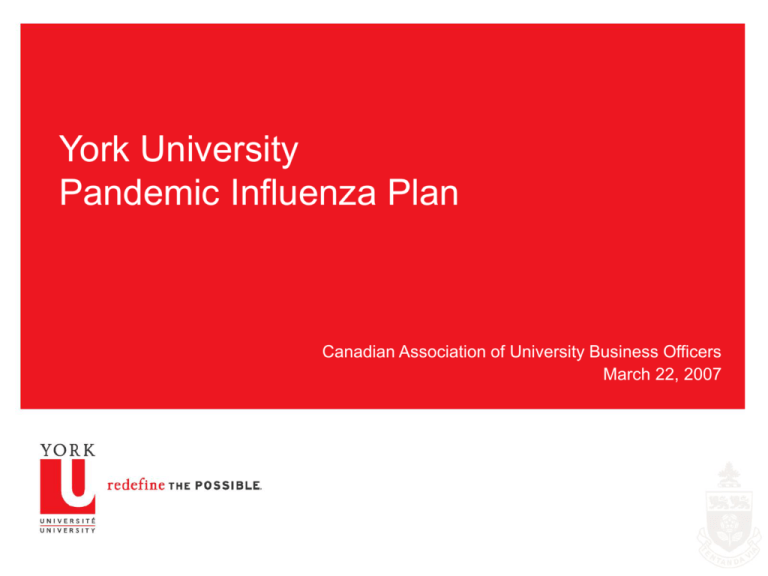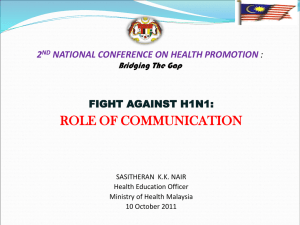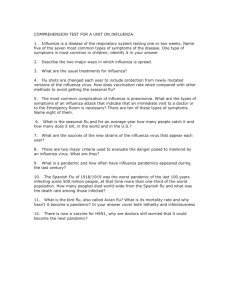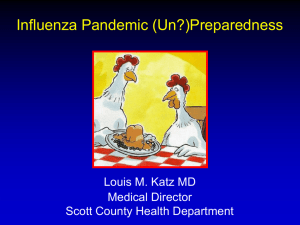York University Pandemic Influenza Plan - Office of the Vice
advertisement

York University Pandemic Influenza Plan Canadian Association of University Business Officers March 22, 2007 Pandemic Influenza Planning Mandate • During Fall 2005, concern was raised at the University Board level about the University’s state of preparedness in the context of escalating international concern about the potential of a pandemic outbreak. • University President mandated the Vice-President Finance and Administration who has responsibility for Emergency Preparedness and Emergency Response within his portfolio • VPFA’s office also had experience of leading crossdivisional working committee during SARS in 2004 2 Pandemic Influenza Planning • Through Fall 2005, York University was already participating in discussions about Pandemic planning with representatives of GTA postsecondary institutions and Toronto Public Health. • An internal University steering committee, working with representatives of Toronto Public Health, commenced the development of a Pandemic Influenza Plan for York. • The University’s plan was designed to parallel the World Health Organization’s model of Alert Phases for a Pandemic, upon which Toronto Public Health also developed its plan. 3 Pandemic Influenza Planning Pandemic Influenza Planning Steering Group Campus Services & Business Operations Computing & Network Services Emergency Preparedness Office Facilities Services Glendon Campus Student Affairs Health Education Housing & Food Services Human Resources & Employee Relations Legal Counsel Marketing & Communications Media Relations Occupational Health & Safety Office of VP Academic Office of VP Finance & Admin. Office of VP Students Registrar Research Services School of Nursing Security Services Transportation Services Student Community Development Resource: Toronto Public Health 4 Pandemic Influenza Planning YORK UNIVERSITY’S PANDEMIC INFLUENZA PLAN Step 1: Identify Existing Frameworks: – World Health Organization Phases of Pandemic Alert – the University’s Emergency Management structure – policies of the University Senate for academic disruptions, class cancellation and sessional dates – Toronto Public Health draft Pandemic Influenza Plan 5 Pandemic Influenza Planning Existing Frameworks World Health Organization Pandemic Alert Phases Interpandemic Period * Phase 1 Phase 2 Pandemic Alert Period ** Phase 3 Phase 4 Phase 5 Pandemic Period Postpandemic Period Phase 6 No new influenza virus subtypes have been detected in humans. An influenza virus subtype that has caused human infection may be present in animals. If present in animals, the risk of human infection or disease is considered to be low. No new influenza virus subtypes have been detected in humans. However, a circulating animal influenza virus subtype poses a substantial risk of human disease. Human infection(s) with a new subtype, but no human-to-human spread, or at most rare instances of spread to a close contact. Small cluster(s) with limited human-to-human transmission but spread is highly localized, suggesting that the virus is not well adapted to humans. Larger cluster(s) but human-to-human spread still localized, suggesting that the virus is becoming increasingly better adapted to humans, but may not yet be fully transmissible (substantial pandemic risk). Pandemic phase: increased and sustained transmission in general population. Return to interpandemic period. 6 Pandemic Influenza Planning Existing Frameworks Managing the Emergency University’s Framework for Emergency Preparedness • Incident Management System (IMS) - Emergency Policy Group - Emergency Management Group - Planning & Analysis - Operations - Logistics - Finance & Administration - Emergency Response - Incident Commander - Emergency Response team (from campus and off-campus) • Unit Specific Emergency Preparedness Plans 7 YORK UNIVERSITY INCIDENT MANAGEMENT SYSTEM ORGANIZATIONAL STRUCTURE EMERGENCY POLICY GROUP (aka Core Crisis Team) VP Finance and Administration President Chief Marketing & Communications Officer University Legal Counsel POLICY E M E R G E N CY O PE RAT I O N S COORDINATION & IMPLEMENTATION Policy Decisions Priorities Strategy Additional members may be added, depending on the nature of the emergency CENTRE Duty Officer (Admin Officer, TBA) Senior Duty Officer (Admin Officer, TBA) EMERGENCY MANAGEMENT GROUP Emergency Manager: AVP Campus Services & Business Operations Safety Officer: Director, Occupational Health & Safety Liaison Officer: Manager Emergency Preparedness Public Information Officer: Director Media Relations (or designate) Scribe: Executive Officer Overall coordination Resource support Operational planning Communication Additional members may be added, depending on the nature of the emergency – e.g., senior representatives from External Emergency Response Agencies Planning & Analysis Operations Logistics Finance/Administration Chief: Sr. EO Finance & Admin. Academic: Assoc. VP Academic, Sr. EO Academic Students: AVP Student Community, University Registrar Facilities: Campus Planner Chief: AVP Facilities Services Security: Operations Manager Research: Assoc. Dir. Research Services CNS: Director IT Infrastructure ITS: Director IT Services Care/Shelter: Director Student Community, Director Housing & Food Services Chief: AVP Finance Procurement: Director Procurement HR: Director HR Services NGO Support: Community Relations Officer Transpo: Manager Transpo. Services Food: Manager Food Services Chief: Comptroller Insurance: Manager Insurance HR&ER: Director Payroll Budget: Manager Budget Audit: Internal Audit designate FI E LD O PE RAT I O N S Incident Commander: Director Security Services P O L I C E, F I R E, E M S / A M B U LA N C E Pandemic Influenza Planning Existing Frameworks Senate policies already in place: • Policy on Academic Implications of Disruptions or Cessations of University Business Due to Labour Disputes or Other Causes • Policy on Class Cancellation • Policy on Sessional Dates and the Scheduling of Examinations included in your binder as Attachments to York’s plan 9 Pandemic Influenza Planning Existing Frameworks Toronto Public Health Toronto Pandemic Influenza Plan (TPIP) http://www.toronto.ca/health/pandemicflu/index.htm 10 Pandemic Influenza Planning YORK UNIVERSITY’S PANDEMIC INFLUENZA PLAN Step 2: Develop a set of Planning Principles and Assumptions and present these to the University Executive Committee for approval. 11 Pandemic Influenza Planning Planning Principles & Assumptions YORK UNIVERSITY’S PANDEMIC INFLUENZA PLAN Planning Principles 1. To safeguard the health and wellbeing of individual members of the University. 2. To protect the academic mission of the University through continuity of core activities. 3. To protect of the long-term interests of the University. 12 Pandemic Influenza Planning Planning Principles & Assumptions 33 Planning Assumptions . . . including • In a pandemic situation, the potential exists for all to be infected, including the emergency response organization and senior University decision-makers as no antivirals will be made available to York employees or students. • In a pandemic situation, processes and actions in York’s Plan are likely to be taken out of the direct control of the University by public health or emergency response agencies. • Previous influenza pandemics have infected regions in multiple waves – the duration of each wave is likely to be 6 to 8 weeks. 13 Pandemic Influenza Planning Planning Principles & Assumptions 33 Planning Assumptions . . . including • 15-35% employee absence as a result of illness, caring for sick family members or friends, closures of schools and daycare facilities, and other absenteeism (per Health Canada). • Up to one-third of the York population or 20,000 people to be affected (per Toronto Public Health). • A potential for between 15 and 105 related deaths of York community members based on mortality rates of 1 in 522 to 1 in 2870 (per Toronto Public Health). York’s mortality rate could be higher if the University is one of the “clusters” hit hardest. 14 Pandemic Influenza Planning Planning Principles & Assumptions 33 Planning Assumptions . . . including • A trigger point for full suspension of operations should be adopted, on the basis of a percentage of the University population (students, faculty and staff) reported absent. • York cannot rely on the Ontario health care system to provide for the care of sick students in residence (who are unable to go home). • York cannot rely on government to provide policy direction before or during a pandemic or on assistance being provided during a pandemic, given the wide-scale demands and limitation of resources. 15 Pandemic Influenza Planning YORK UNIVERSITY’S PANDEMIC INFLUENZA PLAN Step 3 Adopt the University’s Emergency Management structure (IMS) for managing the pandemic emergency. 16 YORK UNIVERSITY INCIDENT MANAGEMENT SYSTEM ORGANIZATIONAL STRUCTURE EMERGENCY POLICY GROUP (aka Core Crisis Team) VP Finance and Administration President Chief Marketing & Communications Officer University Legal Counsel POLICY E M E R G E N CY O PE RAT I O N S COORDINATION & IMPLEMENTATION Policy Decisions Priorities Strategy Additional members may be added, depending on the nature of the emergency CENTRE Duty Officer (Admin Officer, TBA) Senior Duty Officer (Admin Officer, TBA) EMERGENCY MANAGEMENT GROUP Emergency Manager: AVP Campus Services & Business Operations Safety Officer: Director, Occupational Health & Safety Liaison Officer: Manager Emergency Preparedness Public Information Officer: Director Media Relations (or designate) Scribe: Executive Officer Overall coordination Resource support Operational planning Communication Additional members may be added, depending on the nature of the emergency – e.g., senior representatives from External Emergency Response Agencies Planning & Analysis Operations Logistics Finance/Administration Chief: Sr. EO Finance & Admin. Academic: Assoc. VP Academic, Sr. EO Academic Students: AVP Student Community, University Registrar Facilities: Campus Planner Chief: AVP Facilities Services Security: Operations Manager Research: Assoc. Dir. Research Services CNS: Director IT Infrastructure ITS: Director IT Services Care/Shelter: Director Student Community, Director Housing & Food Services Chief: AVP Finance Procurement: Director Procurement HR: Director HR Services NGO Support: Community Relations Officer Transpo: Manager Transpo. Services Food: Manager Food Services Chief: Comptroller Insurance: Manager Insurance HR&ER: Director Payroll Budget: Manager Budget Audit: Internal Audit designate FI E LD O PE RAT I O N S Incident Commander: Director Security Services P O L I C E, F I R E, E M S / A M B U LA N C E Pandemic Influenza Planning YORK UNIVERSITY’S PANDEMIC INFLUENZA PLAN Step 4 Adopt the World Health Organization Hierarchy of Pandemic Alert. 18 Pandemic Influenza Planning Existing Frameworks World Health Organization Pandemic Alert Phases Interpandemic Period * Phase 1 Phase 2 Pandemic Alert Period ** Phase 3 Phase 4 Phase 5 Pandemic Period Postpandemic Period Phase 6 No new influenza virus subtypes have been detected in humans. An influenza virus subtype that has caused human infection may be present in animals. If present in animals, the risk of human infection or disease is considered to be low. No new influenza virus subtypes have been detected in humans. However, a circulating animal influenza virus subtype poses a substantial risk of human disease. Human infection(s) with a new subtype, but no human-to-human spread, or at most rare instances of spread to a close contact. Small cluster(s) with limited human-to-human transmission but spread is highly localized, suggesting that the virus is not well adapted to humans. Larger cluster(s) but human-to-human spread still localized, suggesting that the virus is becoming increasingly better adapted to humans, but may not yet be fully transmissible (substantial pandemic risk). Pandemic phase: increased and sustained transmission in general population. Return to interpandemic period. 19 Pandemic Influenza Planning YORK UNIVERSITY’S PANDEMIC INFLUENZA PLAN Step 5 Create the Master Pandemic Plan by aligning the institution’s planning, mitigation and response actions within each WHO Alert Phase. 20 Pandemic Influenza Planning The Master Plan Align planning, mitigation and response actions within each WHO Alert Phase: – based on approved planning principles and assumptions – experiences of other types of crises or emergencies – for York: SARS, power black-out, union strikes, winter weather emergencies – use the knowledge of the University’s subject experts at the Planning table to determine if action is appropriate, viable and within the proper Alert Phase. 21 Pandemic Influenza Planning YORK UNIVERSITY’S PANDEMIC INFLUENZA PLAN Step 6 Address academic governance issues and the core business activities of teaching, learning and research 22 Pandemic Influenza Planning Academic Governance • University Senate has authority over classes, exams, evaluation, curriculum and academic standards (per York University Act) • Any deviation from normal expectation is governed by Senate decision (e.g., options for curricular remediation or recovery following a disruption) • in respect of academic governance, University President presented initial elements of the steering committee’s draft plan to Senate Executive Committee for review and commentary • Senate Executive provided written response to the steering committee (1) affirming its planning assumptions relating to academic governance and the application of the existing framework of Senate policies and (2) clarifying Senate’s role in a Pandemic emergency. 23 Pandemic Influenza Planning Research Continuity • York’s Plan addresses the continuity of research activities during a closure or operational reduction due to Pandemic outbreak • York’s Plan provides a “planning template” for individual researchers and research groups 24 Pandemic Influenza Planning YORK UNIVERSITY’S PANDEMIC INFLUENZA PLAN Step 7 Develop “Sub-plans” for all areas where essential functions need to be performed during operational reduction or closure. 25 Pandemic Influenza Planning Sub Plans for Essential Functions – – – – – – – Central utilities Security Services Custodial Services Grounds & Waste Disposal Communications Network & System Services Student Housing & Student Support – Maintenance Research laboratories Animal care Occupational Health & Safety Transportation Employee Payroll Pensions & Benefits Treasury Food Service Registrar’s Office & Student Financial Services 26 Pandemic Influenza Planning YORK UNIVERSITY’S PANDEMIC INFLUENZA PLAN Step 8 Other Considerations Additional Key Planning Actions 27 Pandemic Influenza Planning Additional Key Planning Actions and Sub-Plans – – – – – – – – – – – Promotion of Personal Preparedness Hand Sanitizer Health Monitoring and Medical Assistance Tracking of Attendance/Absences of Students Tracking of Attendance/Absences of Employees Protocol for Students in International Programs Use and Supply of Personal Protective Equipment Mutual Aid Stockpiling of Food and Water Recruitment of Volunteers Training of Volunteers 28 Pandemic Influenza Planning Unit Specific Emergency Preparedness Plans • Business Continuity leading up to and during an outbreak - essential functions, key personnel/roles, critical infrastructure - teaching and learning in the context of academic governance - research continuity • Communications Tree • Business Resumption 29 Pandemic Influenza Planning Decision-making Institution: President, with Emergency Policy Group (per IMS) Suspension and Resumption of Academic Classes and other academic matters: Senate Executive, guided by Senate policies Public Health Order: City of Toronto Public Health 30 Pandemic Influenza Planning Continuing Role of Pandemic Steering Committee • Develop University Plan • Implement planning and mitigation actions within the Plan under Alert Phases 1, 2 and 3 • Monitor status of Pandemic Alert • Establish Pandemic web site, initiate communications plan and health education/disease prevention plan • Discuss planning with employee groups 31 Pandemic Influenza Planning END Canadian Association of University Business Officers March 22, 2007





